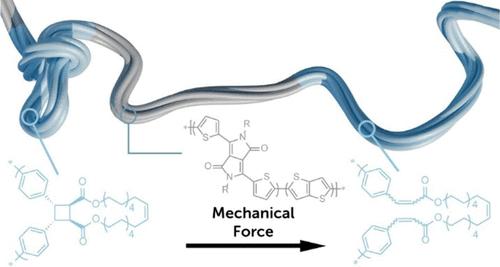Reactive Strand Extension to Improve Stretchability in Semiconducting Polymers
IF 7
2区 材料科学
Q2 CHEMISTRY, PHYSICAL
引用次数: 0
Abstract
As electronics become more seamlessly integrated into our everyday lives, the demand for durable, stretchable, and electron-conducting materials will continue to grow. However, many conductive materials suffer from poor electrical performance under repeated mechanical strain, which limits their lifetime use. Inspired by developments to enhance stretchability in nonconjugated materials with covalent mechanochemistry, we explore reactive strand extension (RSE) as a strategy to mitigate poor electronic performance in conjugated polymer semiconductors under strain. Herein, we incorporated RSE into a donor–acceptor conjugated polymer by copolymerizing cinnamate dimers into the conjugated backbone and evaluated their impact on stretchability. RSE was found to improve stretchability in cross-linked conjugated polymer systems via crack onset strain measurements, atomic force microscopy, dichroic ratio measurements, and grazing-incidence wide-angle X-ray scattering. Lastly, charge carrier mobility measurements from organic field-effect transistors revealed that RSE-containing cross-linked conjugated polymers retained mobility more effectively under mechanical strain compared to unmodified conjugated polymers. Overall, our study presents an alternative strategy to improve the performance of conjugated polymers for stretchable electronics.

活性链延伸提高半导体聚合物的可拉伸性
随着电子产品越来越无缝地融入我们的日常生活,对耐用、可拉伸和导电材料的需求将继续增长。然而,许多导电材料在重复机械应变下的电性能很差,这限制了它们的使用寿命。受利用共价机械化学技术提高非共轭材料可拉伸性的启发,我们探索了反应链延伸(RSE)作为一种策略来缓解应变下共轭聚合物半导体的不良电子性能。本文中,我们通过将肉桂酸二聚体共聚到共轭主链中,将RSE加入到供体-受体共轭聚合物中,并评估了它们对拉伸性的影响。通过裂纹开始应变测量、原子力显微镜、二向色比测量和掠射广角x射线散射,发现RSE可以改善交联共轭聚合物体系的拉伸性。最后,对有机场效应晶体管的电荷载流子迁移率测量表明,与未改性的共轭聚合物相比,含rse的交联共轭聚合物在机械应变下更有效地保持了迁移率。总的来说,我们的研究提出了一种替代策略来改善可拉伸电子产品的共轭聚合物性能。
本文章由计算机程序翻译,如有差异,请以英文原文为准。
求助全文
约1分钟内获得全文
求助全文
来源期刊

Chemistry of Materials
工程技术-材料科学:综合
CiteScore
14.10
自引率
5.80%
发文量
929
审稿时长
1.5 months
期刊介绍:
The journal Chemistry of Materials focuses on publishing original research at the intersection of materials science and chemistry. The studies published in the journal involve chemistry as a prominent component and explore topics such as the design, synthesis, characterization, processing, understanding, and application of functional or potentially functional materials. The journal covers various areas of interest, including inorganic and organic solid-state chemistry, nanomaterials, biomaterials, thin films and polymers, and composite/hybrid materials. The journal particularly seeks papers that highlight the creation or development of innovative materials with novel optical, electrical, magnetic, catalytic, or mechanical properties. It is essential that manuscripts on these topics have a primary focus on the chemistry of materials and represent a significant advancement compared to prior research. Before external reviews are sought, submitted manuscripts undergo a review process by a minimum of two editors to ensure their appropriateness for the journal and the presence of sufficient evidence of a significant advance that will be of broad interest to the materials chemistry community.
 求助内容:
求助内容: 应助结果提醒方式:
应助结果提醒方式:


